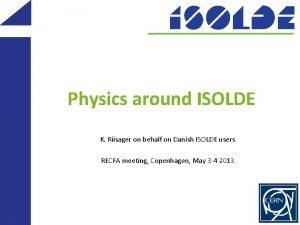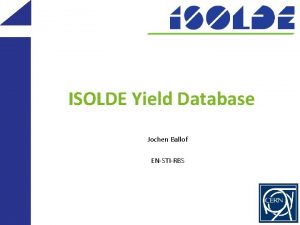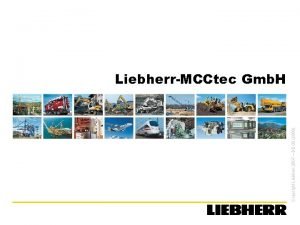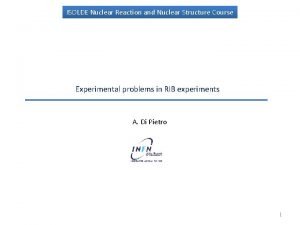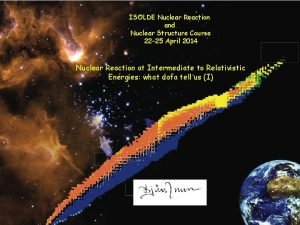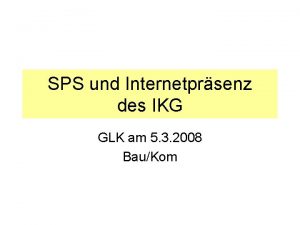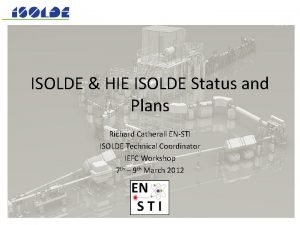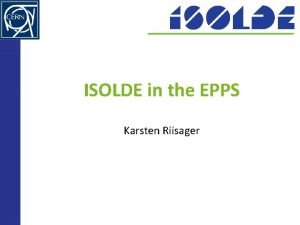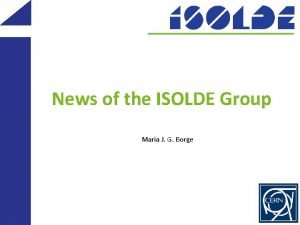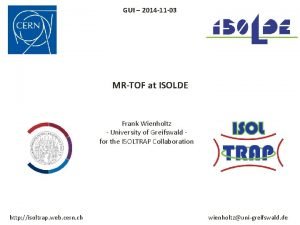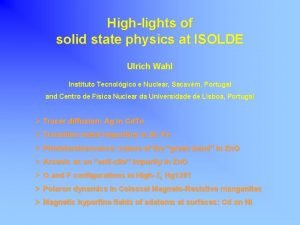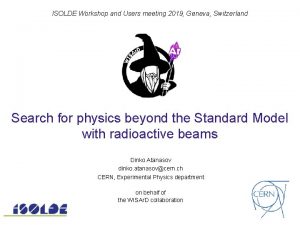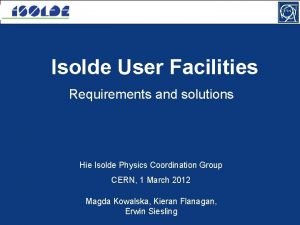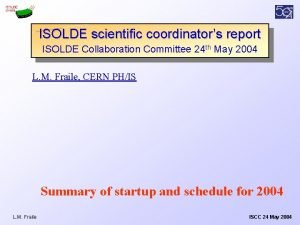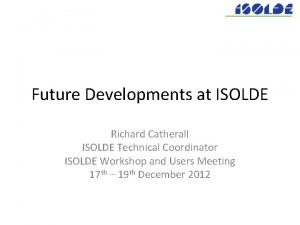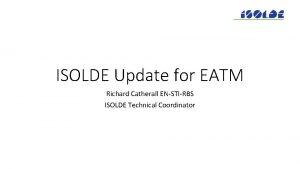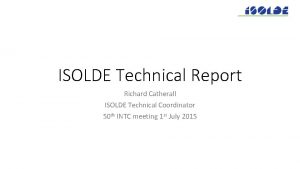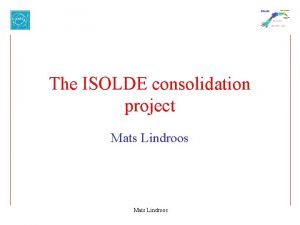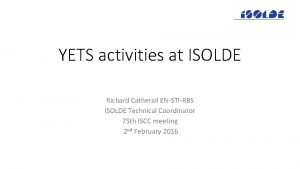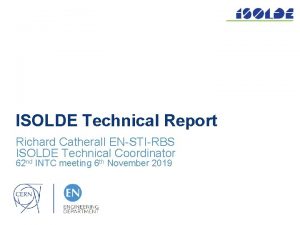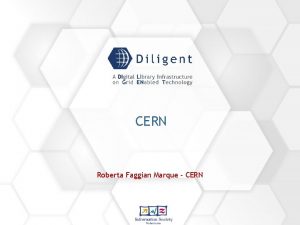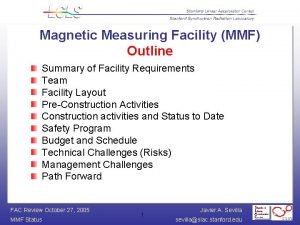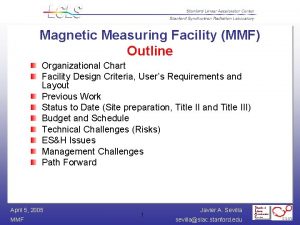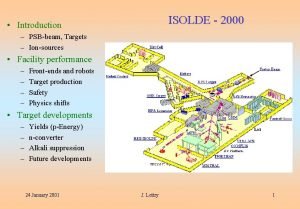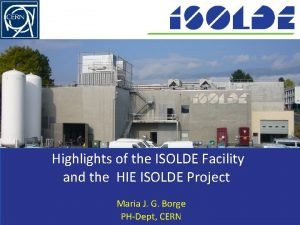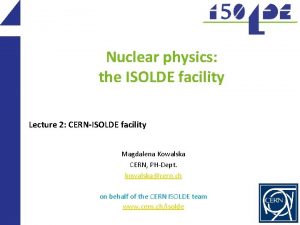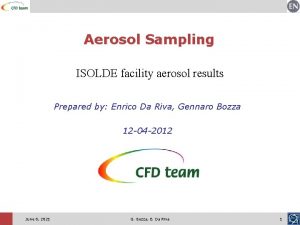The ISOLDE Facility Outline ISOLDE within CERN ISOLDE

































- Slides: 33

The ISOLDE. Facility Outline: ISOLDE within CERN ISOLDE as facility Science and users Examples of experimental setups Magdalena Kowalska ISOLDE Physics Coordinator, CERN, PH-SME-IS

. Facility

Very short. history First beam October 1967 Upgrades 1974 and 1988 New facility June 1992 First ISOL-type facility worldwide

ISOLDE within CERN. accelerators ISOLDE PSB PS LINAC 2 To be upgraded in intensity (2 u. A->6 u. A p to ISOLDE) and energy (1. 4 ->2 Ge. V) To be exchanged by LINAC 4

Nuclei production. and selection

Experimental. setups • First ISOL-type facility • Beams ionised on surface, by lasers, or in plasma Mass-sep. • Beams extracted at 30 -60 k. V HRS • Reacceleration up to WITCH ISCOOL 3. 5 Me. V/u REX-ISOLDE Travelling setups Post-accelerated beams Target stations HRS & GPS PS-Booster 1. 4 Ge. V protons 3× 1013 ppp RILIS NICOLE MINIBALL and T-REX Travelling setups COLLAPS CRIS ISOLTRAP

Nuclear landscape. stable +/EC decay - decay p decay spontaneous fission Proton drip-line protons neutron drip-line Magic numbers neutrons About 300 stable isotopes 3000 radioactive isotopes discovered

Produced. nuclides More than 700 nuclides of over 70 chemical elements produced – by far largest choice among ISOL-type facilities (experience gathered over 40 years)

. Physics

Physics. topics Nuclear physics Strong interaction in many-nucleon systems Nuclear driplines 34 Ne: ? 10 protons + 24 neutrons = Mean field Does it exist? fp-shell sd-shell p-shell s-shell 28 20 8 2 relative abundance Astrophysics Nucleo-synthesis, star evolution Abundances of elements Fundamental studies Beyond standard model (neutrino mass, …) Applications, e. g. Solid state physics, life sciences mass

Physics and. users Physics interest: • Nuclear structure from decay and reactions • Nuclear structure via atomic techniques • Nuclear astrophysics • Fundamental interactions • Solid-state physics • Bio- and medical physics Around 450 users (7% of CERN’s total) User requirements: 25 countries; 100 institutions 175 experiments (in 4 years) • Higher energy for the post-accelerated beam • More beams (intensity wise and different species) 90 active experiments in 2011 • Better beams (High purity beams, low emittances, more flexibility in the beam parameters) => Need upgraded facility : HIE-ISOLDE proposal

Letters of Intent. for HIE-ISOLDE • 34 Letters submitted • 284 Participants from 76 Laboratories in 22 Countries • 30 LOIs make use of the Energy and Intensity increases; 4 of the intensity upgrade only • Major mechanisms are Coulex (13) and transfer(16); elastic scattering (3); fission (2) • (3) letters on masses and moments; (4) astrophysics, (5) major new instrumentation • Major subjects: Nuclear shapes ; Shell evolution; Halo properties; Nuclear astrophysics First call in May 2011 Requested beams

. Experimental techniques

Collinear laser. spectroscopy Laser beam, Laser on fixed frequency COLLAPS setup Ion beam Retardation zone Electrostatic deflection Detection method depends on the case => optimised for best S/N ratio Charge exchange region (if needed) Excitation / Observation region From hyperfine structure and isotope shifts: • Charge radius • Spin, magnetic dipole and quadrupole electric moment

Penning trap mass. spectrometry 2 m Cyclotron frequency in magnetic field => atomic mass determination of cyclotron frequency (R = 107) B = 5. 9 T removal of contaminant ions (R = 105) B = 4. 7 T Bunching of the continuous beam ISOLTRAP setup

Coulomb excitation. (behind REX) Miniball setup: highly efficient gamma detectors and particle detector REXISOLDE E <3 Me. V/u Ge g detectors CD – detector DE-E detector Double sided Si strip detector PPAC target Beam dump detector Beam impurities Excitation of a projectile nucleus (radioactive) by the electromagnetic field of the target (made of stable nuclei) Observables: Transition energies and intensities => Study collective properties and deformations of nuclei

Fast timing decay. studies Gamma spectroscopy with Ba. F 2 crystals (very fast response, <ps lifetime studies) => Transition energies and probabilities, deformations

Transfer reactions. (behind REX) Miniball + T-REX setup (Si detector barrel): gamma detectors and particle identification d p Observables • energies of protons (+ Eg) (single-particle) level energies • angular distributions of protons (+ g-rays) spin/parity assignments • (relative) spectroscopic factors particle configurations g-decay

Solid-state. physics From K. Johnston

Solid-state. physics From K. Johnston

Solid-state. physics From K. Johnston

Bio-physics. From K. Johnston

Medical applications. iv. Injection into mouse i. Collection at ISOLDE v. PET/SPECT imaging and tumor treatment 1. 4 Ge. V Thank you ii. Shipping to PSI iii. Radiochemical purification and labeling

Summary. • ISOLDE is the 1 st ISOL-type facility and can provide over 700 radioactive nuclides to 90 open projects • Physics interest: nuclear physics, via astrophysics and fundamental studies to applications • A dozen fixed setups cover above topics (and many travelling experiments) • HIE-ISOLDE will give users higher intensity and quality of beams, and higher energy of postaccelerated beams


Halo nuclei. Halo: nucleus built from a core and at least one neutron/proton with spatial distribution much larger than that of the core discussed • 1985: first halo system identified: 11 Li • 2005: half-dozen other halos known • Nuclear structure and core-halo interaction still not well understood => Crucial information: Mass/binding energy Spin-parity Magnetic moment Mass and charge radius Quadrupole moment Energy level scheme 11 8 8 11 Li: 3 p, 8 n 208 Pb: 82 p, 126 n

Charge radii of. Ne isotopes Laser spectroscopy Intrinsic density distributions of dominant proton FMD configurations Geithner et al, PRL 101, 252502 (‘ 08) Marinova et al, almost accepted

Exotic. decays 3/2 - Even a neutron rich-nucleus emits charged particles - 20. 6 1996 17. 916 T 1/2 = 8 ms 1983 1966 9 Li+d 9 Li 15. 721 8 Li+t 10. 59 1980 8. 82 1979 7. 315 9 Be+2 n Energy (Me. V) 1974 0. 320 11 Be 0. 504 10 Be+n 8. 982 2 +3 n d p

Penning traps. and masses • Mass determined from ion cyclotron frequency in magnetic field • Penning trap used to confine ions during measurement c = + + A=100, B=6 T • + 1 MHz • - 1 k. Hz • z 44 k. Hz

ISOTOPE production.

Physics. topics Applied Physics Nuclear Decay Spectroscopy and Reactions Structure of Nuclei Exotic Decay Modes Implanted Radioactive Probes, Tailored Isotopes for Diagnosis and Therapy Condensed matter physics and Life sciences Fundamental Physics Direct Mass Measurements, Dedicated Decay Studies - WI CKM unitarity tests, search for b-n correlations, right-handed currents Atomic Physics Laser Spectroscopy and Direct Mass Measurements Radii, Moments, Nuclear Binding Energies f(N, Z) Nuclear Astrophysics Dedicated Nuclear Decay/Reaction Studies Element Synthesis, Solar Processes

Examples of physics. topics • Nuclear Physics – shell closures, shape evolution shape coexistence, halo nuclei … • Fundamental interactions – P, T violation, neutrinos, Vud matrix element • Solid state physics – semiconductors spintronics, nano… • Biophysics, medical physics – Radioisotopes, heavy metal toxicity

REX. EBIS • Super conducting solenoid, 2 T Nier-spectrometer • Electron beam < 0. 4 A 3 -6 ke. V • Select the correct A/q and separate the radioactive ions from the residual gases. • A/q resolution ~150 • Breeding time 3 to >200 ms • Total capacity 6· 1010 charges • A/q < 4. 5 REXEBIS MASS SEPARATOR Optional stripper 9 -GAP RESONATOR Experiments 3. 0 Me. V/u Linac Length Freq. Duty cycle Energy A/q max. 18 May 2009 7 -GAP RESONATORS 2. 2 Me. V/u IH Rebuncher 1. 2 Me. V/u 11 m 101 MHz (202 MHz for the 9 GP) 1 ms 100 Hz (10%) 300 ke. V/u, 1. 2 -3 Me. V/u 4. 5 (2. 2 Me. V/u), 3. 5 (3 Me. V/u) ISOLDE RFQ 0. 3 Me. V/u ISOLDE beam Primary High en target driver b 60 ke. V protons REXTRAP efficiency : 1 landscape -10 % New. Total opportunities in the physics at CERN REX-trap • Cooling (10 -20 ms) Buffer gas + RF • (He), Li, . . . , U • 108 ions/pulse (Space charge effects >10 5)
 Quotation sandwhich
Quotation sandwhich Isolde k
Isolde k Isolde yield database
Isolde yield database Isolde liebherr
Isolde liebherr Isolde
Isolde Isolde martinson
Isolde martinson Isolde kurz gymnasium reutlingen
Isolde kurz gymnasium reutlingen Isolde
Isolde @isolde
@isolde Maria jg
Maria jg Isolde frank
Isolde frank Isolde reveal
Isolde reveal Isolde workshop
Isolde workshop ưu thế lai là gì
ưu thế lai là gì Thẻ vin
Thẻ vin Thơ thất ngôn tứ tuyệt đường luật
Thơ thất ngôn tứ tuyệt đường luật Cái miệng nó xinh thế
Cái miệng nó xinh thế Các châu lục và đại dương trên thế giới
Các châu lục và đại dương trên thế giới Bổ thể
Bổ thể Từ ngữ thể hiện lòng nhân hậu
Từ ngữ thể hiện lòng nhân hậu Diễn thế sinh thái là
Diễn thế sinh thái là Tư thế ngồi viết
Tư thế ngồi viết V cc
V cc Làm thế nào để 102-1=99
Làm thế nào để 102-1=99 Bài hát chúa yêu trần thế alleluia
Bài hát chúa yêu trần thế alleluia Hổ sinh sản vào mùa nào
Hổ sinh sản vào mùa nào đại từ thay thế
đại từ thay thế Vẽ hình chiếu vuông góc của vật thể sau
Vẽ hình chiếu vuông góc của vật thể sau Công thức tính độ biến thiên đông lượng
Công thức tính độ biến thiên đông lượng Thế nào là mạng điện lắp đặt kiểu nổi
Thế nào là mạng điện lắp đặt kiểu nổi Hát kết hợp bộ gõ cơ thể
Hát kết hợp bộ gõ cơ thể Tỉ lệ cơ thể trẻ em
Tỉ lệ cơ thể trẻ em Lời thề hippocrates
Lời thề hippocrates Dot
Dot

